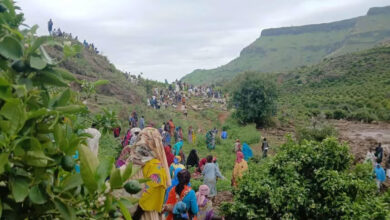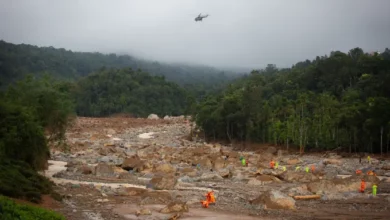A report released Tuesday by London-based rights watchdog Amnesty International (AI) urged the Egyptian government to take "immediate and inclusive steps" to protect residents of slum areas situated in the hills of Cairo’s Muqattam district. Muqattam is home to the now-infamous El-Duweiqa shantytown, which suffered a disastrous rockslide in September 2008 that killed more than 100 people, injured 58 and left thousands displaced.
In that tragedy, doomed inhabitants were crushed in their sleep when massive boulders tumbled down from the Muqattam hills above. Many survivors, whose homes were flattened by the landslide, were later relocated to tenement projects sponsored by Egyptian first lady Suzanne Mubarak.
Those living nearby also saw their homes — already sporting cracked walls and caved-in ceilings — demolished and eventually removed. Large families, rendered homeless overnight, were forced to squeeze into two-bedroom apartments in far-away neighborhoods.
AI’s 55-page report, entitled "Buried Alive: Trapped by Poverty and Neglect in Cairo’s Informal Settlements," documents the aftermath of the Duweiqa incident and warns of possible future landslides in the same area. The report notes that the 1,750 families since relocated from the area to new tenements never received legal tenure, making them subject to possible eviction. Single mothers and divorced women, meanwhile, were denied new housing outright.
The report also decries the methods in which relocations were carried out. It notes that the removal of families from their homes in both Duweiqa and neighboring Establ Antar had been abrupt and forcible, and were carried out by security forces "in breach of procedural protections required under international human rights law." Those removed from Establ Antar in particular, the report states, had been transferred to a "remote area" in 6th of October City.
The AI report further notes that the official investigation into the year-old tragedy has yet to produce any concrete findings.
Salah Mohamed, an expert at the government-run Astronomical and Geophysical Research Institute (AGRI), told Al-Masry Al-Youm English Edition that the Egyptian Mineral Resource Authority’s technical committee had already produced a comprehensive study of the disaster. The authority, however, could not be reached for comment, while no reports on the incident appeared to be available on its website.
In 1997, the AGRI provided Cairo Governorate authorities with a detailed report on the relative safety of the Muqattam area, which was never followed up on. After the report was issued, says Mohamed, the AGRI never heard back from the relevant authorities.
"The main problem with the slums is water leakage," he told Al-Masry Al-Youm English Edition, noting that the area lacked working sewage and water systems. "So residents use cesspools that discharge into the rocks below, causing erosion."
What’s more, the haphazard fashion in which settlements are built at the foot of the Muqattam hills serves to further contribute to the potential for rockslides, Mohamed points out. "If water problems and arbitrary building are resolved, we could avoid similarly fatal landslides," he said.
Some, including AI in its report, argue that the Duweiqa disaster could have been averted had the warnings issued by AGRI — and others — been taken seriously at the time.
"Studies initiated by the government following a deadly 1993 rock fall in the neighboring el-Zabaleen informal settlement had identified danger zones all around Muqattam hills," the report states. "Residents living in the vicinity of the hill had informed the authorities that cracks were appearing in the walls of their homes, and they feared for their safety. A contractor hired by local authorities to secure rocks on the hill repeatedly warned the authorities about the high risk of a rock fall."
The report goes on to state: "Despite all the warnings issued months before the rockslide, authorities failed to evacuate impoverished residents and provide them with temporary or alternative housing."
The AI report also warns that there are still at least 26 "unsafe areas" at risk of rockslides and other dangers in the immediate vicinity. These areas were likewise identified as "dangerous" by a long-term government development plan (to be completed by 2050), according to the AI report, which goes on to point out that little or nothing has yet been done in this regard.
Many inhabitants of these unsafe areas, including 140 families in the Haret Ahmed Nader and El-Shohba shantytowns, now refuse to leave their homes. "They told AI that they would rather live in danger than sleep in the street with their children, but are haunted by the Duweiqa rockslide," the report states.
Sabrin Hamed Abulelah, who lives with her husband and four children in a single room in Haret Ahmed Nader, said that she and other residents had staged a protest outside Manshiyet Nasser’s local authorities earlier this year, demanding relocation to the Suzanne Mubarak tenement project. According to the report, protestors were dispersed by police after being promised alternative housing — a promise that was never kept.
"An enumeration committee came to Haret Ahmed Nader, drew up a list of residents and told them to pack their belongings," the report notes. "Since then, nothing has happened."
The AI report goes on to recommend a "mass evacuation" of endangered areas, especially spots where the risks are seen to be immediate, and for providing residents with "adequate" housing. It goes on, however, to express fear that the government might fail to protect the poorest inhabitants of these areas, as it did in 2008. The report quotes Duweiqa residents as saying that thousands of their loved ones remain missing in the wake of the disaster.
“Thousands of Egypt’s poor are trapped by poverty and neglect that could ultimately end in their deaths,” AI Middle East and North Africa Director Malcolm Smart was quoted as saying in a press release. “The government must urgently address the risks faced by those living in areas designated as ‘unsafe’ and find solutions by consulting with those directly affected.”
He added that many people "continue to live in fear on precarious hillsides or under high voltage power lines because they have nowhere else to go."
Smart went on to say that Egyptian authorities "owe this to both the victims and those who survived that awful morning [in 2008], just as they owe it to others at risk to ensure that there is no repetition and that the tragedy of El-Duweiqa is not played out again in any of Cairo’s other ‘unsafe areas.’" Egypt’s poor, he concluded, "should not have to live any longer with the threat of being buried alive.”
According to AI, roughly half of Greater Cairo’s estimated urban population of 13.5 million currently live in informal settlements built on either agricultural or desert land.
The Ministry of Housing, Utilities and Urban Development could not be reached for comment for this report.




